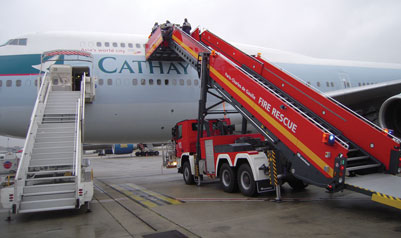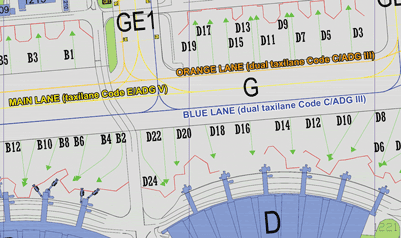Airfield Operations: Accommodating the next generation of airliners
- Like
- Digg
- Del
- Tumblr
- VKontakte
- Buffer
- Love This
- Odnoklassniki
- Meneame
- Blogger
- Amazon
- Yahoo Mail
- Gmail
- AOL
- Newsvine
- HackerNews
- Evernote
- MySpace
- Mail.ru
- Viadeo
- Line
- Comments
- Yummly
- SMS
- Viber
- Telegram
- Subscribe
- Skype
- Facebook Messenger
- Kakao
- LiveJournal
- Yammer
- Edgar
- Fintel
- Mix
- Instapaper
- Copy Link
Posted: 12 February 2014 | Gaël Le Bris, Airside Development Manager for Aéroports de Paris at Paris-Charles de Gaulle Airport
Airport compatibility and correct technical policy to accommodate NLAs is vital. Gaël Le Bris, Airside Development Manager at Aéroports de Paris, shares Paris-Charles de Gaulle Airport’s work into this important issue.
Paris-Charles de Gaulle (CDG) Airport welcomes around 600 aircraft (1,200 flights) on a daily basis. This fleet includes various aircraft types operated by more than 200 airlines – from the ATR 42 to the A380. The Aerodrome Operator Certificate (AOC) specifies four design aircraft – the A340-600, the 777-300ER, the A380-800 (2006) and the 747-8 (2013). They are the four biggest airliners, designated by the ICAO as ‘NLA’, for New Longer (A340-600 and 777-300ER) or Larger (A380-800 and 747-8) Aircraft.
In June 2007, just two years after ICAO issued Documents 301 and 305 establishing standards for accommodating the NLA, Paris-CDG welcomed its first A380-800. Today, eight airlines serve the airport with the A380-800 or the 747-8, and this figure should rise again in 2014 – the year which marks the airport’s 40th birthday. This is possible thanks to two decades of teamwork between the stakeholders of the aircraft/airport compatibility. It is also the result of the airport operator’s technical policy for upgrading an ICAO code letter E (FAA ADG V) airport to code letter F (ADG VI) aircraft.
From the runways to the stands without restriction
Paris-CDG has two independent complexes of two parallel runways. The outer runways are used preferentially for landing and offer a Landing Distance Available (LDA) of 2,700m. They were built in 1997 and 2000 respectively, and initially designed with a 60m-wide bearing pavement, in compliance with the standards for the code letter F of Annex 14.
The inner runways are mainly used for take-off, with a Take-off Runway Available (TORA) of about 4,200m. They were originally designed for the code letter E, but the A380 and the 747-8 can use them because they were certified for operating on 45m-wide runways. The two long runways were upgraded with 15m of extra-paved shoulders (see Figure 1), and consequently offer the same level of protection against the ingestion of foreign object debris as the outer ones; meeting the recommendations of the A380 Airport Compatibility Group (AACG) – a coalition of major airport operators, National Aviation Authorities, and Airbus1.


Figure 1: Runway pavement widths at Paris-Charles de Gaulle Airport
Only the first usable rapid exit taxiway of the two outer runways, in each direction of landing, are not yet open to the taxiing of the A380 and the 747-8.
In addition to the upgrade of the runways and exit taxiways, studies were conducted with the French DGAC (National Aviation Authority) to verify that:
- An A380-800 at the CAT I or CAT III holding points do not create disturbance of the ILS beyond ICAO tolerances for the aircraft landing on the same runway
- An A380-800 can land and take-off safely with another A380-800 at a holding point, despite the height of its tail (use of a Collision Risk Model).
Regarding the taxiways, over the past decade a wide network for the A380 has been upgraded, with the exception of that serving Concourses S3 and S4, which was initially designed for code letter F aircraft. This network is one of the longest in the world open to code letter F aircraft without any restrictions – this is particularly remarkable as the airport was initially designed within ICAO code letter E standards. On these taxiways, any design aircraft can cross another design aircraft.
The South Cargoport (taxiways U and C) was more specifically upgraded for the 747-8 in 2012. Boeing’s super cargo aircraft has been serving Paris-CDG since January 2013, and is operated by AirBridge Cargo and Cathay Pacific on a regular basis.
The upgrade program and the operating conditions on the existing taxiways are based on a safety study completed in 2005. The lateral deviations of 30,000 aircraft were measured including 7,600 wide-body aircraft. One of the main results of the study is that the deviation of an aircraft does not depend significantly on the size of the aircraft or its speed.
In addition, a probabilistic model of the deviations was built. It demonstrates that the NLA can safely operate on taxiways with a width of 23m (ICAO code letter E standard) or even 22.5m (former French DGAC standard for code letter E); meeting the ICAO safety objectives. Based on the results of the same model, the distance between the centreline and an object can be reduced from 57.50m (ICAO code F standard) to 49m, as proposed by the AACG in which Aéroports de Paris was deeply involved.
In addition, obstacles between 45m and 49m from the centreline can be tolerated if their height is limited to 4.5m. This result allows Aéroports de Paris to conduct construction works within the limits of the taxiway strips. It significantly reduces their impact on the operations, and offers proper conditions for the civil engineering works.
Pavement engineering
Beyond the airside design, the entry-intoservice of the NLA challenges the aviation pavements. Because of its weight and the configuration of its main gear (two bogies of six wheels), the 777-300ER has the highest Aircraft Classification Number of the worldwide commercial fleet. The A380 has the highest maximum ramp weight and maximum take-off weight, at around 550 tonnes. The airliners now or soon-to-be entering into service, and notably the 787 and the A350, also have high tyre pressures (16.6 bars for the A350-900). Consequently, the critical constraints on the pavements have become more varied.
These changes need to be taken into account for the requirements of new projects as maintenance programs. For instance, the size of the standard concrete slabs was reduced from 7.5m x 7.5m to 5m x 5m. This follows the recommendations of the A380 PEP Rigid2; a study conducted in 2005 for assessing the impact of the A380 on the existing pavements.
Aircraft stands and terminal facilities
Twenty-three stands are currently able to accommodate the A380-800 at Paris-CDG – 12 of them are served by the L and M lobbies of Concourses S3 and S4; CDG’s most modern terminal facilities opened in 2007 and 2012. They can simultaneously (and without interference) accommodate a wide-body, thereby increasing the capacity of Terminal 2E. Four stands were created at Terminal 1, and one at Terminal 2C, in parallel with an interior modernisation program. Other stands are in development to meet the future demand.
About 15 of these stands have three passenger gates each, including a bridge able to reach the upper deck of the A380. This equipment is essential for reducing the turnaround time of this aircraft type, typically by 40 per cent, to 90 minutes. It also offers the airlines a better way to manage the boarding and deplanement of their first class passengers (depending on the configuration of their cabin).
Flight safety first
As with any aircraft, the A380-800 and the 747-8 must be de-iced prior to take-off during icy conditions, and especially in the most severe weather conditions. Since the opening of the airport, de-icing and anti-icing operations have been completed on centralised de-icing facilities. Three quarters of them are performed within four de-icing areas which consist of four pads each and are located at the thresholds of the runway complexes. Any of these 16 pads are able to accommodate the entire fleet serving the airport.
The original de-icing procedure, developed for the code letter F (ADG VI) aircraft, involves up to six one-man operated de-icing rigs. It typically takes around 18 minutes to treat an A380 with one-step (de-icing only) and between 20 and 30 minutes for a two-step treatment (de-icing and then anti-icing).
An airport must have the appropriate RFFS (Rescue and Fire Fighting Services) category for welcoming the NLA. Paris-CDG is certified with a RFFS category 10, which is the highest existing standard and a requirement for the A380 and the 747-8. It certifies that airport firefighters are able to intervene on an aircraft with an overall length of more than 76m and a fuselage width up to 7m.
In addition, Paris-CDG purchased a fourwheel Rosenbauer E8000 rescue stair in 2012 (see Figure 2, page 45). This non-mandatory vehicle allows the firefighters to reach the doors of the lower or upper deck of any commercial aircraft, from the low MD80 series to the high A380. It has a large stair and offers several useful options (such as spotlights, fans and extrication plier) to the acting staff. Consequently, it significantly enhances access to an aircraft that is on fire or expediting evacuation after a runway excursion.


Figure 2: The Rosenbauer E800 rescue stair is able to reach the upper deck of a 747 or A380
The next compatibility challenges
The A380-800 was a milestone in terms of airport compatibility, and Paris-CDG developed a new approach of cooperation with aircraft manufacturers, the airlines, and the air navigation service provider. However, a second code letter F aircraft entered into service in 2011 – the 747-8. At the same time, more than a dozen new airliner programs performing their maiden flights within the two next decades were launched. Facing these potential changes in the fleet mix, Paris-CDG created a permanent workgroup dedicated to share the information about short- and long-term airport compatibility issues across its departments, and then plan the related technical studies and safety assessments.
The coming decade will see the rise of the widest aircraft of code letter C (ADG III). Indeed, aircraft manufacturers are introducing new models with wider wingspans into the market. The A320Ceo with sharklets, the A320Neo, the 737MAX and the CS100/300 all have a wingspan higher than that of the original A320Ceo, and close to the limit of the code letter C (36m).
Some parts of Paris-CDG’s airside are designed for the A320Ceo, such as the dual taxi lanes serving terminals 2A, 2C, and 2F. Two A320s can taxi independently on the two outer taxi lanes (blue and orange), or a code letter E (ADG V) aircraft can taxi on the main centreline (yellow). These taxi lanes will be resized to the full code letter C standards (see Figure 3, page 46).


Figure 3: Dual taxi lane GOLF along aprons BRAVO and DELTA
The future will see new challenges with the next wide-body generation of aircraft. If the most recent airliners (787 and A350) fit into the dimensions of the existing design aircraft, it will not be the case of the 777-X. Indeed, the preliminary length of version -9X is greater than that of the longest airliner in service (the A340-600). Consequently, careful study of the position of this aircraft on existing code letter E and F stands, and the impact on surrounding activities (aircraft safety margins, handling processes, road safety, etc.), is required. However, the choice of the manufacturer to introduce folding wingtips will significantly improve its compatibility with the existing facilities – this technology would enable the aircraft to convent from code letter F to E after landing and prior to take-off.
This approach of airport compatibility is also an opportunity for revising the current practices for welcoming (punctually) the ‘rare birds’ of the AOC. In particular, in 2014 the airside community will be preparing new procedures for simplifying the venue of the Antonov 124 and 225. This work anticipates also the future conversion of certificate under the rules of the European regulation EU-ADR.
References
- This workgroup specified recommendations for welcoming the A380 on aerodromes where a full upgrade to ICAO code letter F standards was not possible. A similar workgroup led by Boeing issued equivalent recommendations for the 747-8 (BACG)
- The A380 Pavement Experimental Program (PEP) was performed by the coalition of Airbus, the IFSTTAR Laboratory (formerly LCPC), the DGAC/STAC (formerly STBA), with the contribution of Aéroports de Paris
Biography
Gaël Le Bris holds two MSc degrees and is Airside Development Manager for Aéroports de Paris at Paris-Charles de Gaulle Airport. Gaël is in charge of monitoring and coordinating the airside development projects and is also responsible for their safety risk management. He leads the airport com – patibility studies and the activity of economic and technical benchmarking for his department



















Great article Gael.